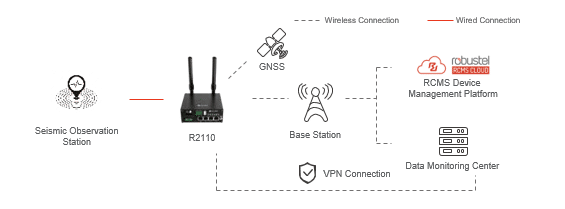A lot of seismic observation stations are situated in remote areas with limited access to fixed network resources. It is frequently too expensive to deploy dedicated lines for these stations. Finding a dependable and reasonably priced network connection solution is crucial to overcoming this difficulty.
Timely and accurate transmission of field data to the data center is crucial for the seismic background field detection system's effectiveness. A stable network connection is fundamental to achieving this goal.
Furthermore, the data transmission used by seismic monitoring equipment is based on specific industrial protocols. As a result, choosing networking equipment that is compatible with such protocols is necessary.
By creating a dependable and cost-efficient earthquake monitoring system solution, Robustel believes that they significantly improve the efficacy and accuracy of the seismic background field detection system. Therefore, let’s find out how Robustel earthquake monitoring system solution works.
The Solution: Earthquake Monitoring System Solution
An innovative and cost-effective approach is essential to achieving quick and dependable transmission of data in seismic monitoring.
Robustel RCMS and R2110 industrial routers can be used to build a reliable networking system. This guarantees the seismic monitoring system dependable connectivity and smooth data uploading.
Deployed in remote places, the Robustel R2110 industrial router minimizes maintenance expenses due to its cost-effective design and support for many protocols.
Key Features:
Here are the key features of Robustel’s Earthquake Monitoring System Solution:
Stable Connection
Even in areas with limited network coverage, the R2110 industrial router guarantees dependable connections and reliable data transmission from seismic monitoring equipment.
Low-cost Management Method
Seismic observation stations can now manage their networks more easily and affordably thanks to the RCMS platform, which also makes remote access, quick data downloads, and reliable connections possible.
Data Stability and Real-time Performance
Through timely data uploads and proactive maintenance procedures, Robustel's industrial routers and RCMS management platform collaborate to guarantee the stability, dependability, and preventative maintenance of seismic background field detection systems.
The Topology
The components of the seismic observation network include a base station for data transmission, an R2110 device at a seismic station for data collecting, and a data monitoring center outfitted with a Robustel RCMS platform for cloud storage and remote device management. Both conventional (base station to data monitoring center) and wireless (GNSS and base station) connections can be used to transmit data securely over a VPN.
Why Choose Robustel Devices to Earthquake Monitoring Sytem Solution
For early warning systems and disaster preparedness, reliable, dependable, and real-time seismic monitoring is essential. Selecting the right equipment is crucial to ensure your monitoring system's efficacy. Devices from Robustel have a special set of properties that make them ideal for applications involving seismic monitoring.
Robustel Advantages:
Robust Industrial Design. Robustel's industrial-grade casing, which is made to resist extremes in humidity, dust, vibration, and electromagnetic interference, is a testament to their dedication to quality. This guarantees the dependable operation of your earthquake monitoring device in any setting.
Dual SIM Card Design. When it comes to vital applications like monitoring earthquakes, network resilience is crucial. By enabling the device to move between two distinct cellular networks, Robustel's dual SIM card design minimizes the possibility of a communication breakdown and provides redundancy.
Serial Ports & Digital IO Onboard. Maximum flexibility for Modbus RTU interface applications is provided by the smooth integration of legacy serial devices with RS232/RS485 interfaces. The digital IO also has control and status indication capabilities.
Multiple Gigabit Ethernet Ports. Robustel devices can easily manage multi-device access since they have four 1000M Ethernet ports and an integrated network switch. This allows data transfer from several sensors and instrument within your seismic monitoring network to occur smoothly.


